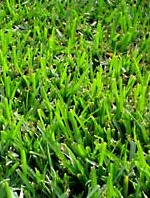 Common Bermuda grass is a fine textured warm-season grass that can be a tough attractive turf or a wretched weed depending on where it is growing. It spreads quickly by stolons and seeds, and has become invasive in many areas earning the common name devilgrass. A native of Africa, it was introduced into the US in 1751 and is now widespread in the South and southwest. It has high tolerance to traffic, heat and drought but is intolerant of shade and cold temperatures. When day time temperatures are consistently below 60 it will turn brown so should be overseeded with annual ryegrass or tall fescue to produce a more attractive lawn in winter. It adapts to a wide range of soils including those with low fertility but needs nitrogen to produce a fine turf.
Common Bermuda grass is a fine textured warm-season grass that can be a tough attractive turf or a wretched weed depending on where it is growing. It spreads quickly by stolons and seeds, and has become invasive in many areas earning the common name devilgrass. A native of Africa, it was introduced into the US in 1751 and is now widespread in the South and southwest. It has high tolerance to traffic, heat and drought but is intolerant of shade and cold temperatures. When day time temperatures are consistently below 60 it will turn brown so should be overseeded with annual ryegrass or tall fescue to produce a more attractive lawn in winter. It adapts to a wide range of soils including those with low fertility but needs nitrogen to produce a fine turf.
Light: Full sun
Water: Deeply and infrequently; drought tolerant
Method of Reproduction: Sod; sprigs at the rate of 2 bushesl/1,000 sq ft; 2-inch plugs at 12 inches apart; seed 1-2 pounds/1000 sq ft
Mowing: ¾ to 1.5 inch high with reel or rotary mower once or twice per week in peak season; for golf course type of turf mow 1/4-1/2″ 3-4 times per week in peak season.
Fertilizing: 2-6 pounds nitrogen/1000 sq ft.
Pests and Diseases: In humid area brown patch, dollar spot, leaf spot, pythium blight, armyworms, an sod webworms may be a problem.
Outstanding Selections: ‘Yuma”, ‘Sundeveil’; ‘Santa Ana’ and ‘Midway’ (more cold hardy).
